- Faculty News
- Student News
- Lab News
- Publications
- Meetings and Presentations
- Outreach
- Grants
- Announcements
- About This Newsletter
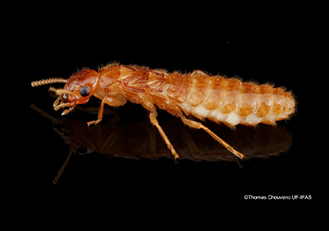
ABOVE:A 7-yr old king of the Formosan subterranean termite, Coptotermes formosanus. Termite primary reproductives are known to be the longest living insect as adults on earth. Picture: Dr. Thomas Chouvenc
The photographic work of Dr. Thomas Chouvenc was featured in the latest edition of American Entomologist, as part of their “Through the Loupe” series. https://academic.oup.com/ae/article/67/3/11/6366639.

Dr. Thomas Chouvenc and colleagues, who recently published a paper in PRSB on the evolution of leading-following behaviors was highlighted in several media outlet (Mizumoto N, Lee S-B, Valentini G, Chouvenc T, Pratt S. 2021. Coordination of movement via complementary interactions of leaders and followers in termite mating pairs. Proceedings of the Royal Society B Lond. 288: 20210998. https://doi.org/10.1098/rspb.2021.0998):
(*) Scientists Hone in on How Termites Coordinate Mating Behavior for Colony Success
https://www.pctonline.com/article/scientists-hone-in-how-termites-coordinate-mating-behavior-colony-success/
(*) Pest Control Clues: Mating termites ‘Follow the Leader’
https://www.futurity.org/invasive-termite-species-2637642-2/
(*) Scientists zero in on how termites coordinate mating behavior for colony success
https://www.southcentralfloridalife.com/indiantown/stories/scientists-zero-in-on-how-termites-coordinate-mating-behavior-for-colony-success,23895
(*) Scientists zero in on how termites coordinate mating behavior for colony success
https://phys.org/news/2021-10-scientists-termites-behavior-colony-success.html
(*) Scientists are focusing on how termites coordinate mating behavior for success
https://floridanewstimes.com/scientists-are-focusing-on-how-termites-coordinate-mating-behavior-for-colonial-success/354141/
Congratulations to our Entomology and Nematology students receiving ENSO travel grants for 2021-2022.
Katie Carroll - $500
James Pinkney - $250
Joshua Botti-Anderson - $250

Ph.D. candidate Leo Ohyama was invited to present an in-person talk at Yale University's Center for Biodiversity and Global Change October 5th-8th.
The talk was titled "Constructing a comprehensive global ant trait database" and represents work done in collaboration with the Yale Center for Biodiversity and Global Change.

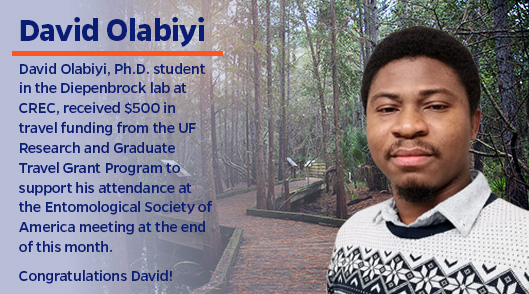

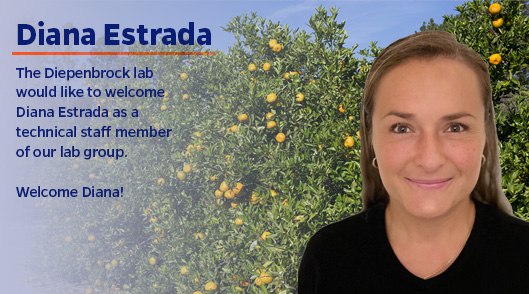
Need to name that bug? A host of experts are available to help Floridians identify any insect or related arthropod. If a mystery creature has six or more legs, the UF Insect ID Lab is the place to call.
Fall is the time of year when the twostriped walkingstick, Anisomorpha buprestoides, is most often observed. If you have lived in Florida for any amount of time, you are probably familiar with these insects that are often seen as mating pairs on sidewalks and buildings. They are unusual among walkingsticks in that they have a defensive secretion. It is sprayed from glands in the thorax, and often aimed at the eyes of an attacking animal. Small dogs sometimes experience this. It is very painful initially, but doesn’t seem to cause lasting damage.
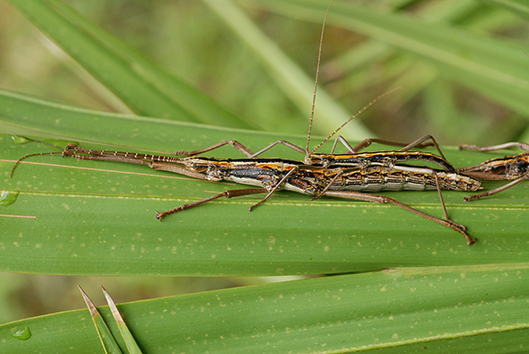

Think it might be a nematode problem? The Nematode Assay Laboratory serves Florida and other states by providing nematode assays and expert advice regarding nematode management.
For more information on the Nematode Assay Laboratory, please contact the lab manager Dr. Billy Crow.

The Reeves Lab, in collaboration with Nathan Burkett-Cadena, Christina Romagosa, Katie Sieving and Sam Wisely, was awarded $173,752 for their UF Deluca Preserve/Forest Systems Jumpstart Program proposal “Vertebrate surveys through mosquito blood meal-derived DNA at the DeLuca Preserve.”

The loudest cricket in Cuba comes to Florida; a cautionary tale
Singing Insects of North America (SINA) is a web site whose purpose is to “help users identify all species of crickets and katydids from America north of Mexico.” Because the males of most species of these two taxa produce species-specific calls that attract sexually responsive females, tracing the calls in a geographic locality to their sources is a good means of learning what species are present. Of the approximately 153 species of crickets known from the US, Anurogryllus celerinictus, aka the Indies short-tailed cricket or the “loudest cricket in Cuba.” The latter name is among the strangest, but it is justified by a paper mentioned below. Anurogryllus, the genus name, translates as “field cricket without a tail” [the female has no ovipositor that can be seen from above] and “celerinictus” translates as “fast calling,” a reference to its impressive wingstroke rate of ~180/sec at 26 C maintained continuously for minutes on end during calling. An example of how loud this cricket can be is that a recording released by the US State Department as a possible acoustic weapon created by the Castro regime to harm US diplomats proved to be indistinguishable from the call of A. celerinictus (see paper by Stubbs and Montealegre-Z published by bioRxiv in 2019). Prior to 2018 the only US records of A. celerinictus were a very few, in 1970, from the lower Florida keys, where they were easily located and identified by their loud songs. Anurogryllus celerinictus was included in the earliest versions of SINA, where they were explained as being “waifs” that must have been carried the 90 miles to the lower Keys in thunderstorms originating in Cuba. These remained the only Florida records for 48 years!
On 15 July 2018 Brandon Woo, guided by their calls, caught two males of A. celerinictus in metropolitan south Florida, one in Homestead and the other in south Miami. In August 2021, he caught 5 males at lights in south Miami and reported that they were abundant! Where did these come from? For the 2018 specimens the blame surely falls on the 2017 hurricane Irma. This infamous and unprecedented storm was born near Cape Verde on the southern Atlantic coast of Africa. From there it proceeded as shown by this map and described in its legend. The map below Irma’s (i.e. a map of Eta, a 2020 Hurricane) shows yet another unprecedented storm (in ways described in its legend). The take-home message from this account of recent hurricanes is in the last paragraph (in red).
Should you be interested in how one might go to SINA and piece together the information used to create the “tale” above, here is how you could do it: go to the species page of Anurogryllus celerinictus, read what is there, and follow the links you are offered. Should you want to be sure you have not missed some essential information, here are the three places where A. celerinictus is the subject: its species page, its map page, and its treatment in the alien species portion of SINA.Aran P, Aguilar P, Bowen T, Farson M, Tapia J, Vimercati L, Darcy JL, Solon AJ, Porazinska D, Schmidt SK, Dorador C. Insights into an undescribed high‐elevation lake (6,170 m asl) on Volcán Llullaillaco: A physical and microbiological view. Aquatic Conservation: Marine and Freshwater Ecosystems. 2021 May 14.
Cerritos-Garcia, D. G., Avery, P. B., Martini, X., Candian, V., Cano, L. M., & Cave, R. D. (2021). In Vitro Effects of Leaf Extracts from Brassica rapa on the Growth of Two Entomopathogenic Fungi. Journal of Fungi, 7(9), 779.
Crow WT. 2021. Root-knot nematodes on warm-season turf: Chasing the ghost. Golf Course Management September 2021:88-93.
Lewald KM, Abrieux A, Wilson DA, Lee Y, Conner WR, Andreazza F, Beers EH, Burrack HJ, Daane KM, Diepenbrock L, Drummond FA, Fanning PD, Gaffney MT, Hesler SP, Ioriatti C, Isaacs R, Little BA, Loeb GM, Miller B, Nava DE, Rendon D, Sial AA, da Silva CSB, Stockton DG, Van Timmeren S, Wallingford A, Walton VM, Wang X, Zhao B, Zalom FG, Chiu JC. Population genomics of Drosophila suzukii reveal longitudinal population structure and signals of migrations in and out of the continental United States. G3 (Bethesda). 2021. jkab343. https://doi.org/10.1093/g3journal/jkab343
Multiple‐trophic patterns of primary succession following retreat of a high‐elevation glacier. W Hu, SK Schmidt, P Sommers, JL Darcy, DL. Porazinska. Ecosphere. Vol 12, issue 3, e03400, https://doi.org/10.1002/ecs2.3400
Porazinska DL, de Mesquita CP, Farrer EC, Spasojevic MJ, Suding KN, Schmidt SK. Nematode community diversity and function across an alpine landscape undergoing plant colonization of previously unvegetated soils. Soil Biology and Biochemistry. 2021 Aug 5:108380.https://doi.org/10.1016/j.soilbio.2021.108380
Rozwalak P, Podkowa P, Buda J, Niedzielski P, Kawecki S, Ambrosini R, Azzoni RS, Baccolo G, Ceballos JL, Di Mauro B, Ficetola GF, Franzetti A, Klimaszyk P, Łokas E, Ono M, Parnikoza I,Pittino F, Poniecka E, Porazinska DL, Schmidt SK, Sommers P, Souza-Kasprzyk J, Stibal M, Szczuciński M, Uetake J, Wejnerowski L, Takeuchi N, Zawierucha K.2021. Cryoconite – from minerals and organic matter to bioengineered sediments on glacier’s surfaces. STOTEN. In Press.
Shrestha, B., Martini, X., & Stelinski, L. L. (2021). Population fluctuations of Diaphorina citri and its natural enemies in response to various management practices in Florida. Florida Entomologist, 104(3), 178-185.
Solon A, Mastrangelo C, Vimercati L, Sommers P, Darcy J, Gendron E, Porazinska DL, Schmidt SK. Gullies and Moraines Are Islands of Biodiversity in an Arid, Mountain Landscape, Asgard Range, Antarctica. Frontiers in Microbiology. 2021;12:1362.

New on Featured Creatures:
bean flower thrips, Megalurothrips usitatus Bagnall, written by Rafia Khan, Dakshina Seal and Rosan Adikari.
black-banded honey bee, Sulawesian honey bee, Apis nigrocincta Smith, written by Lisa Rodriguez, Brynn Johnson, and Cameron Jack.
Himalayan giant honey bee, cliff honey bee (suggested common names), Apis laboriosa Smith, written by Michelle Gregory and Cameron Jack.
rice root-knot nematode, Meloidogyne graminicola, written by Hung X. Bui, Clemen J. Oliveira, Johan A. Desaeger:, and Nathan E. Schroeder.
little fire ant, Wasmannia auropunctata (Roger), written by Virginia Rose Seagal and Andrea Lucky.
cowpea weevil, Callosobruchus maculatus (Fabricius 1775), written by Garima Garima, Rafia Khan, and Dakshina Seal.
Do you have a favorite creature? Learn how to make it into a Featured Creatures!
Dr. Thomas Chouvenc gave a seminar at the Southwest Pest Management Conference 2021 which was held virtually on Sept 30th, and provided insight on how termite baits impact the egg-laying activity of queens.

The 2021 IPM Academy, led by Hugh Smith, was held September 21, 2021 in Citra, Florida. Participants were taught the core concepts and skills needed to design integrated pest management programs for vegetable, fruit, ornamental and field crops. They were also taught to use resources available within IFAS and beyond for diagnosing and addressing arthropod pest problems of diverse commodity groups. Sessions combined PowerPoint and hands-on activities led by a group of entomologists with diverse pest management responsibilities from throughout the state.
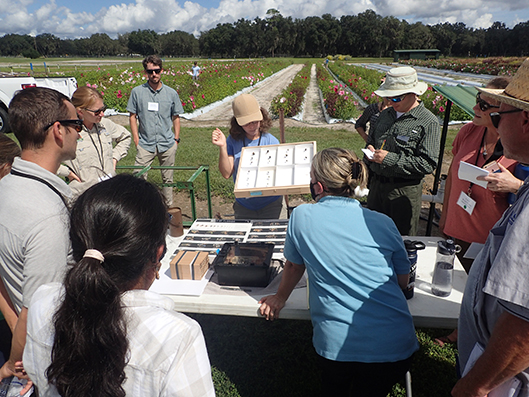
ABOVE: Dr. Rachael Mallinger teaches “Creating pollinator-friendly landscapes.”

ABOVE: Dr. Silvana Paula-Moraes describing her new cotton pest app.
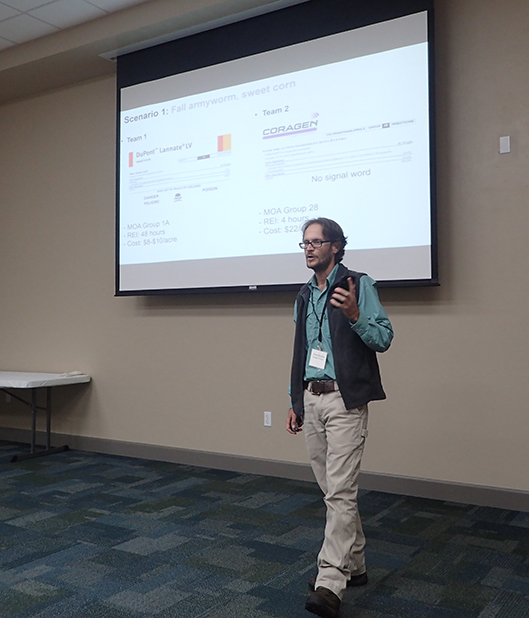
ABOVE: Dr. Julien Beuzelin explaining the use of conventional and biological insecticides.

The 2021 Society of Nematologists Meeting was held in Gulf Shores Alabama. The meeting was dedicated to the memory of Dr. Grover Smart, retired UF Nematology Professor and SON Fellow who passed in 2020.
UF Nematology Students Rock!

ABOVE: J McQueen pictured here with Dr. Porazinska, won the best student paper competition for his oral presentation “Species identity as a dominant driver for the assembly of nematode gut microbiomes in the Dry Valleys of Antarctica”. McQueen JP, Gattoni K, Gendron EJL, Sommers P, Darling J, Schmidt SK, Porazinska DL. at the 2021 Society of Nematologists Annual Meeting, Gulf Shores, AL.

ABOVE: The University of Florida student team consisting of Katie Gattoni, Parr J. McQueen, Rachel Shepherd, Christian Kammerer won the Cobb Bowl competition at the 2021 Society of Nematologists Annual Meeting, Gulf Shores, AL.
Rachel Shepherd received a student travel award from Bayer at the 2021 Society of Nematologists Annual Meeting, Gulf Shores, AL.
Worms et al. oral presentations at the 2021 Society of Nematologists Annual Meeting, Gulf Shores, AL
Shepherd R, Brigham LM, Bueno de Mesquita CP, Smith JG, Schmidt SK, Suding KN, Porazinska DL. Long-term nitrogen deposition in alpine tundra alters nematode communities.
Sandoval-Ruiz R, Grabau Z, Seepaul R, Wright D, Small IM. Reniform nematode management with Brassica carinata in the southeast United States.
Borgmeier A, Gattoni K, Harris T, Mullin P, Porazinska D, Powers K, Wedin D, Powers T. Nuance or numbers: Taxonomic bias in approaches to measure nematode biodiversity.
Mishra S, Salichs O, DiGennaro PM. Plant and root-knot nematode co-expression networks of diurnally regulated genes implicate metabolic pathway.
Budhathathoki S, Wang K-H. Strategies to enhance the efficacy of entomopathogenic nematodes for the management of diamondback moth and imported cabbageworm.
Gattoni K, Borgmeier A, Gendron E, McQueen JP, Mullin P, Poers K, Powers TO, Porazinska DL. Potential role of the filtering framework in nematode community assembly.
McQueen JP, Gattoni K, Gendron E, Sommers P, Darling J, Schmidt S, Porazinska DL. Species identity as a dominant driver for the assembly of nematode guy microbiomes in the dry valleys of Antarctica.
De Oliveira C, Subbotin SA, Inserra RN, Brito JA, Desaeger J. An update of some foliar nematodes in Florida, Louisiana, and North Carolina: Species delimination and notes on their phytoparasitic status.
Kammerer C, Alake G, Crow WT. Differential effects of fluopyram and abamectin on Belonolaimus longicaudatus and Meloidogyne graminis in vitro.
Tsegay M, Grabau ZJ. Efficacy of nematicides at managing plant parasitic nematodes in field corn.
Liu W, Gattoni K, Adhikari A, Park SW. Cotton tolerance against Rotylenchulus reniformis employs jasmonate signaling in root hair development.
Digennaro P, Mishra S, Hu W. Basal plant biology and its roles in host responses to root-knot nematode.
Bui HX, Gu M, Desaeger JA. A nematode survey on Asian vegetable farms in central Florida.
Noling J, Desaeger J. Better bed wetting via assessment of the radial spatial pattern of chemical tracer moving through soil.
Habteweld A, Mendes ML, Inserra RN, Crow WT. Phylogenetic relationships of some Belonolaimus longicaudatus populations associated with turfgrasses in the southeastern USA.
Bogale M, Sampson E, Hu W, Baniya A, Mishra S, Doty A, Zhang DA, Amador M, Guryanova O, Mathieu M, Shabashvili D, Miranda M, Xoi L, DiGennaro P. Monoclonal antibodies for the identification of plant-pathogenic nematodes.
Alake G, Musa N. 50 Years of nematology research: Changing research themes and implications for the future.
Gendron E, Sevigny JL, Powers TO, Thomas WK, Byiringiro I, Porazinska DL. Utilizing shotgun mitochondrial metagenomics for improved data collection and identification of nematodes.
Porazinska DL, Bueno de Mesquita CP, Farrer EC, Spasojevic MJ, Suding KN, Schmidt SK. Response of nematode communities to climate-driven plant colonization of a high alpine landscape.
Wang K-H, Waisen P, Paudel R, Budhathathoki S, Uyeda J, Relationships between nematode community and incidence of asparagus crown and root rot.
Moreira D, Desaeger J. Effect of new non-fumigant nematicides on the motility and mortality of different trophic groups of nematodes.
Grabau ZJ, Sandoval-Ruiz S. Fumigation chemistries and methods for Meloidogyne incognita management in sweetpotato.
Crow WT, Snyder R, Frank J. Effects of pesticide and root health programs on a golf course putting green infested by multiple plant-parasitic nematodes.
Desaeger J, Bui HX. Chloropicrin fumigation on the first crop increases root-knot nematode damage on cucurbit double crops.
Grabau ZJ, Liu C, Navia Gine PA. Fluensulfone and fumigation for sting nematode management in potato production.
Crow WT, Thoden TC, Agi A, Habteweld A. Reklemel active as a nematicide for warm-season turfgrasses.
Baniya A, DeGennaro P. Metagenomic approach to decipher host-parasitic interaction among native entomopathogenic nematodes.
Dritsoulas A, Wu S-Y, Duncan LW. Arthropod community responses reveal potential predators and prey of entomopathogenic nematodes in a citrus orchard.
Regmi H, Vallad GE, Hutton SF, Desaeger J. Interaction studies between Meloidogyne javanica and Fusarium oxysporum f. sp. Lycopersici (FOL) race 3 on different isolines of tomato cv. Tasti Lee.
Hughes K, Mishra S, DeGennaro PM. Quantifying plant parasitic nematode nitrogen assimilation with isotope enriched proteomics.
Riva G, Bui HX, Gu M, Desaeger JA. Distribution of root-knot nematodes in Florida with focus on Meloidogyne enterolobii.
Jagdale G, Oliveira-Hofman C, Chavez D, Blaauw BR, Duncan L, Colson G, Bock CH, Shapiro-Ilan D. Comparative efficacy of fluensulfone and Steinernema carpocapsae against plant nematodes.
Agudelo P, Corbin J, Desaeger J, Gorny A, Grabau Z, Guan Z, Hajihassani A, Mueller J, Quesada-Ocampo L, Rutter W, Wadl P. A multi-state effort to contain and manage Meloidogyne enterolobii in vegetable crops.
Wram C, Hesse C, Vieria P, Eves-van den Akker S, Myers R, Humphreys-Pereira D, Coyne D, DiGennaro P, Lopez-Nicora H, Cedeno A, Emmanuel O, Saikai K, Duncan L, Guzman O, Cobon J, Chinnasri B, Inserra R, Zasada I. Global comparative genomics of Rodopholus similis.
Liu C, Grabau ZJ. Nematode management in Florida sweet potato using non fumigant nematicides.
Schumacher L, Grabau Z. Vertical distribution of nematodes in peanut-cotton cropping systems.
Entomology Education and Outreach News
return to topDon’t forget the Entomology and Nematology Education and Outreach Program is available and will accommodate both virtual and approved in-person presentations!
Recent Outreach events: Whew what can we say…we’ve been busy, busy, busy; things are starting to pick up and it seem like we are almost back to normal. 😀
September 14th – Cornerstone Preschool: Jennifer Standley gave a Zoom presentation to the 3rd grade class. They learned all about entomology, the department, and saw the petting zoo.
September 18th to 20th – Girl Scout Festival: The arthropod Zoo was loaned out for an event that featured over 500 youth in Tampa, FL
September 24th – Ambleside School: Jennifer Standley gave a tour of the department to a group of 7th graders and Dr. Roberto Pereira gave a very entertaining tour of the Urban Lab. I think they could have spent all day at the urban lab 😀
September 28th – TV20 “Wildlife Wednesday”: Jennifer Standley and Dr. Rebecca Baldwin were recorded for upcoming “Wildlife Wednesday” clips on TV20. Jennifer featured honey bees and Dr. Baldwin featured bed bugs.
September 29th – Santa Fe College Recruitment Day: Dr. Rebecca Baldwin spent her evening at the college hoping to bring in some new entomologists.
September 29th – “Meet UF” event: Dr. Rebecca Baldwin spent her time at the Smathers Library.
October 4th – Baby Gators: Jennifer Standley and Joshua Botti-Anderson (Mallinger Lab graduate student) dressed in costume for the two year olds. We were so impressed they can count to 20 and now know how many legs insects and spiders have! We also had fun having them learn how to collect insects with a net (see photo below).
October 7th – Washington Classical School: This group of 4/5th graders enjoyed a tour of the department. Dr. Phil Koehler gave a fun presentation at the urban lab showing of roach tractor pull, termites trailing pen on paper, and “Who’s most Attractive” mosquito demonstration. Jennifer Standley showed them the petting zoo and the Honey Bee Lab and Dr. Rebecca Baldwin also accompanied.
October 7th – Single Moms Program: Dr. Rebecca Baldwin gave a presentation on entomology and showed off the critters to the mothers and children.
October 9th – Jacksonville Garden Club: Jennifer Standley, Madison Heisey, Margaret Anderson, and Sarah Tafel made a road trip to Jacksonville. Madison and Margaret gave an entertaining presentation on “Spiders Aren’t Scary” and all sorts of arachnids accompanied them.
Upcoming Outreach events: VOLUNTEERS NEEDED
October 24th – UMC Campus Churches (Two shifts: 2:30-6:30 & 4-8): We are in need of assisting Dr. Amanda Hodges with two booths set up with a showing and petting of the arthropods for this spooky Halloween event (4-5 volunteers needed).
November 14th – Trout Lake Nature Center (10-5pm): “Sunday Funday: Bugs and Butterflies”. There will be several displays and stations for the visitors to view. This will be a fun road trip (2hrs each way) to the event and you can hitch a ride in the outreach van (2-3 volunteers needed).
November 18th – Suwannee CARES Event (1-10pm) located in Live Oak. This is a huge event that will have 500-600 attendees and recognizes farmers for their excellence in environmental stewardship. We will have a booth set up with lots of displays and the zoo. 3-4 volunteers are needed.

Entomology on the Go -
What’s better than a live show and tell of some really cool arthropods?! Our live petting zoo consists of: tarantulas, scorpions, vinegaroons, bess beetles, Madagascar hissing cockroaches, and native insects, when in season. With a short training program, they are available for you to check out should you be leading an outreach event, even if it is virtual. The critters are always popular with both youth and adults and are used as a tool to expose the public to STEM disciplines. We have large wood and Plexiglas cages for viewing our native orb weaving spiders. There is one travel cage and one larger static cage. We also have activity kits and lesson plans that are available as well. Please be sure to contact us and review the protocol on transportation and handling of the animals. If you lead an outreach event, be sure to fill out a documentation form so your event can be included in the newsletter and we can log all outreach events. Also note that volunteering to assist with outreach events will count as departmental service for ENSO travel grants. (Please note that some venues require background checks or additional screening.)
If you have any questions or would like to volunteer, please email us.
Cheers! - Jennifer Standley, Outreach Coordinator.
https://entnemdept.ufl.edu/outreach/department-outreach-information/

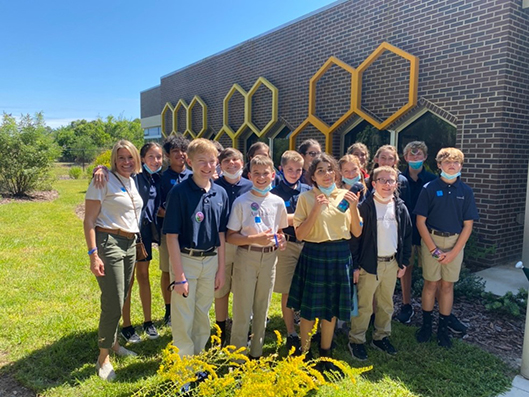
ABOVE: Ambleside 7th Grade students in front of the honey bee lab during their departmental tour.
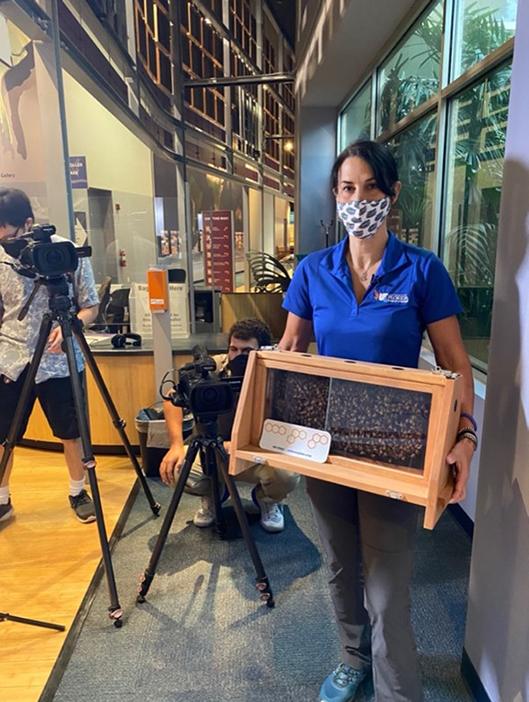
ABOVE: Jennifer Standley speaking for TV20’s “Wildlife Wednesday” on honey bees.
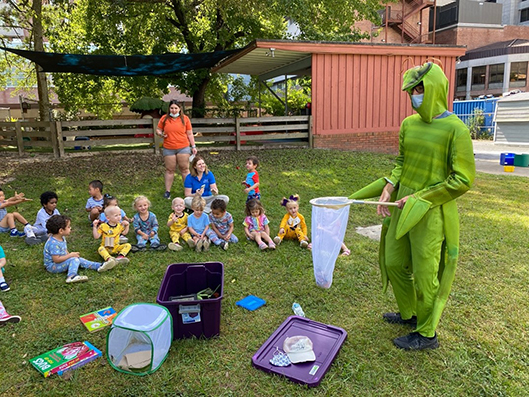
ABOVE: Joshua Botti-Anderson pictured in the mantis costume showing the two year old Baby Gators how to collects insects.
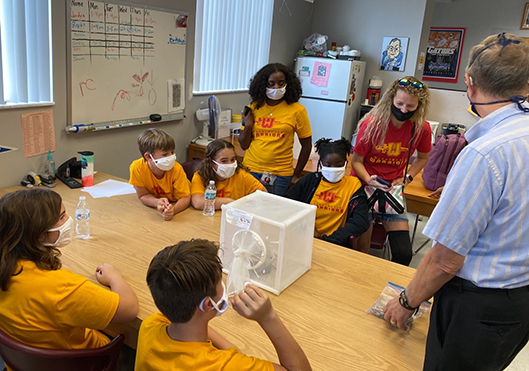
ABOVE: Dr. Phil Koehler showing the Classical Washington School students “Who’s the Most Attractive” mosquito demonstration.
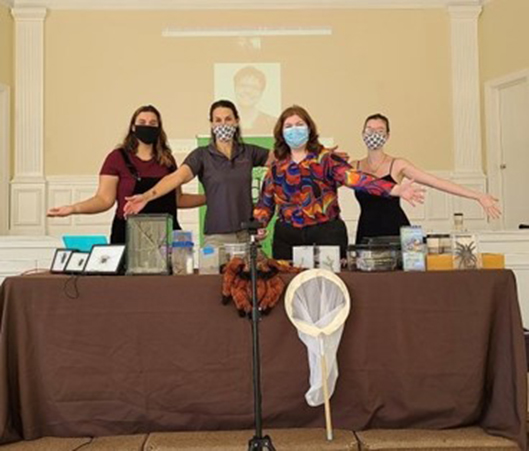
ABOVE: Left to right: Margaret Anderson, Jennifer Standley, Sarah Tafel, and Madison Heisey presenting at the Jacksonville Garden Club “Spiders Aren’t Scary”.
Getting social!
Use #UFBugs so our department can find and share your social posts easily!
Dr. Oscar Liburd is a Co-PIi on a SARE proposal that was awarded. The Principal Investigator Md Babar is from the Agronomy department. As a Co-PI, Dr. Liburd was awarded $60,214.17. The title of the project is “Evaluating the Dual-Purpose of Chickpea: A Cash and Cover Crop for Agricultural Production Systems in the Southeast”.
Dr. Rebecca Baldwin is a PI on an FDAC proposal that has been awarded. The amount funded is $52,256 and the title is “Evaluation of a nanoparticle encapsulated permethrin formulation against three species of adult mosquitoes: Aedes aegypti, Culex quinquefasciatus and Anopheles quadrimaculatus.”
Want grant writing tips? Check out the UF Libraries Grants Management Program
The School of Structural Fumigation will resume on November on Nov 15th, after a year-long hiatus. https://conference.ifas.ufl.edu/fumigation/
Want to stay up to date? Check out our website home page for a link to our Google calendar.
Kay Weigel is the acting interim newsletter editor and does the HTML coding. Newsletters usually are published around mid-month. Submit items for an issue by the seventh of the month.
We like to share news when it happens using our social media outlets: Twitter, Facebook and YouTube. Follow us on these sites for daily updates! When you send news, we will post it on one or more of these sites and again in the monthly newsletter. Please be sure you have permission from people in photographs you submit for publication.
UF-Bugnews-L listserv subscribers receive notices when issues are posted. Our home page has instructions for subscribing and unsubscribing.
Special thanks to James Brown and Nancy Sanders for reviewing the newsletter for errors, and to Jane Medley and Don Wasik for webpage build and design.
Give Back
Want to support the UF Entomology & Nematology Department? Consider making an online gift today! Questions can be directed to Cody Helmer at (352) 392-1975 or chelmer@ufl.edu.